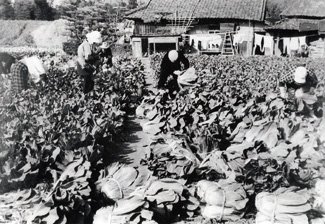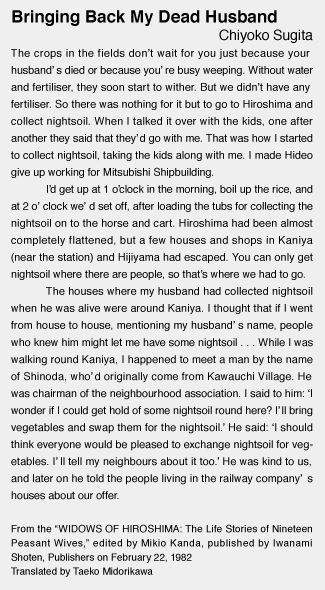Kawauchi-mura Volunteer Citizen Corps
At the end of July, just before the A-bombing, Kawauchi-mura Volunteer Citizen Corps received a dispatch order for building demolition around Nakajima-shin-machi (now, Peace Memorial Park area) in Hiroshima City and for airport construction in Yachiyo-cho, Takata-gun. Members from the district of the former Nukui-mura, one of two villages which were later merged into Kawauchi-mura, were dispatched for building demolition. Members from the district of the other village, the former Nakachoshi-mura, were dispatched for airport construction. Approximately 200 members who were dispatched to Hiroshima City died in the bombing.
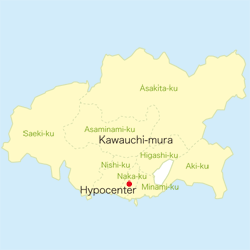
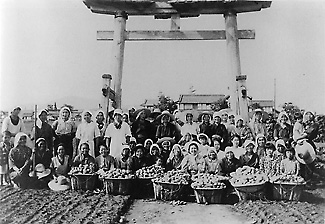
Supporting the food supply in Hiroshima
Kawauchi-mura was the production site of vegetables that contributed to the food supply in Hiroshima. Many varieties of vegetables, including Sato Daikon white radish and Hiroshima-na, were originally grown in the village. In times of war, even vegetables were to be grown in response to the military demand. Kawauchi-mura supplied vegetables to Kure City, the location of the naval forces, in addition to Hiroshima City, the location of the army.
Nukui Hachiman Shrine in wartime
Source: “Recollection of Sato-cho” issued in August 1996 edited by the Sato District Community Building Council
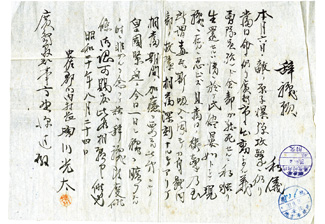
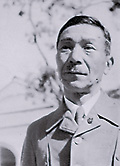
Kota Masukawa
Letter of Resignation
The commander of the Kawauchi-mura Volunteer Citizen Corps was Village Chief Kota Masukawa. In the morning on August 6, 1945, Masukawa led his corps members to Seiganji Temple (now, “Fountain of Prayer” area in Peace Memorial Park) which was located near the site of building demolition works. He was exposed to the bomb while going to the Prefectural Office (now, Kako-machi) to report that his corps members had arrived at the site. Running for his life, Masukawa returned to Kawauchi-mura. While his corps members were annihilated because they were exposed to the bomb at a place near the hypocenter, Masukawa, who survived, submitted his letter of resignation to Asa Regional Office on August 24 to take responsibility for the death of his corps members.
Courtesy of Kozo Masukawa
Shiraume Group
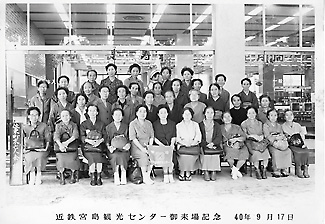
On February 4, 1949, when women in Kawauchi-mura who had lost their husbands in the war assembled, the “Shiraume Group” was established. Members talked about their problems and helped each other, and even went on excursions.
1965
Courtesy of Yukiko Takasaki
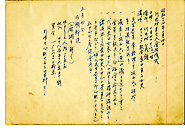 Notebook of Shiraume Group
Notebook of Shiraume Group
This is an activity record of the Shiraume Group from its establishment on February 4, 1949. The content includes offers of side jobs, the opening of lectures, and shellfish gathering.
Collection of Minako Ishigame
Praying

Masako Nomura (then, 24, at the foreground in the photograph) is also one of the women who lost their husbands in the A-bombing. After the bombing, her husband, Nobuichi (then, 28) was put on board a riverboat and returned to his home. However, he died in agony that night.
After his death, Masako almost lost her will to live, but she could not help reconsidering and stopped crying when she recollected her husband’s brutal death. She led a sad life but has lived through it. In Kawauchi-mura, where many women were in the same situation, the fact that she was not alone has served as a mental support for Masako. On the 6th every month, the bereaved in Kawauchi including Masako Nomura offer prayers for their loved ones.
May 6, 2010 Jogyoji Temple
A-bomb victims
On August 6, approximately 500 Kawauchi-mura Volunteer Citizen Corps members were dispatched to the Nakajima District. Members of the Advance Party were exposed to the bomb when they were about to be engaged in work at the operation site, and approximately 200 of them died. Only seven of them breathed their last after returning to their homes. Members of the Backup Party experienced the A-bombing on their way to the operation site. Some of them returned home unwounded but not a few of them suffered from symptoms of radiation sickness caused by the atomic bomb. People who went to the center of Hiroshima City to search for their families were also exposed to the residual radiation.
On the “Monument for Volunteer Citizen Corps” established in Nakajima-cho, names of 180 deceased A-bomb victims are inscribed.
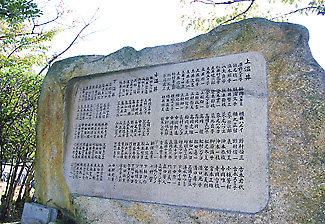
Farming with the whole family
Most of the residents of Kawauchi-mura were farmers. Nearly 80 women lost their husbands simultaneously due to the A-bombing. It was not an easy thing for these women to continue farming without their breadwinners. Bereaved wives and children worked from early morning till late at night in full force. Some children gave up going on to higher education to help the family make a living.
Around 1955 Kawauchi
Source: “Recollection of Sato-cho” issued in August 1996 edited by the Sato District Community Building Council
